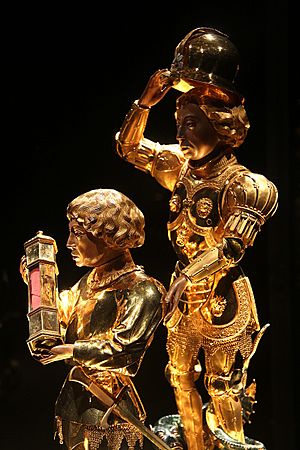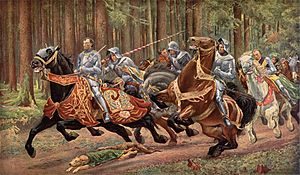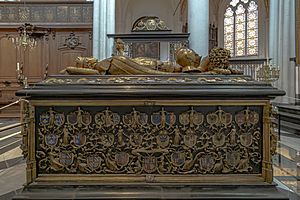Charles the Bold facts for kids
Quick facts for kids Charles the Bold |
|||||
|---|---|---|---|---|---|

Charles in about 1460, wearing the collar of the Order of the Golden Fleece, painted by Rogier van der Weyden, Gemäldegalerie, Berlin
|
|||||
| Duke of Burgundy | |||||
| Reign | 15 June 1467 – 5 January 1477 | ||||
| Predecessor | Philip the Good | ||||
| Successor | Mary the Rich | ||||
| Born | 10 November 1433 Dijon, Burgundy |
||||
| Died | 5 January 1477 (aged 43) Nancy, Lorraine |
||||
| Burial | Church of Our Lady, Bruges | ||||
| Spouse |
Catherine of France
(m. 1440; d. 1446)Isabella of Bourbon
(m. 1454; d. 1465) |
||||
| Issue | Mary the Rich | ||||
|
|||||
| House | Valois-Burgundy | ||||
| Father | Philip the Good | ||||
| Mother | Isabella of Portugal | ||||
| Religion | Roman Catholicism | ||||
| Signature | |||||
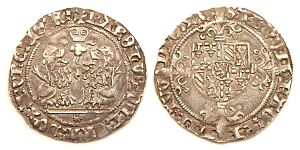
Charles I (born November 10, 1433 – died January 5, 1477), also known as Charles the Bold, was a powerful ruler in Europe. He was the Duke of Burgundy from 1467 until his death in 1477.
Charles had a big dream: he wanted to become a king! He hoped to turn his growing lands, known as the Burgundian State, into a strong, united kingdom. He even declared his lands independent and expanded them by buying or conquering new areas like Alsace, Zutphen, Guelders, and Lorraine. This helped connect his northern and southern territories.
However, Charles's ambitions made many other European rulers upset. This led to a series of wars called the Burgundian Wars. His early death in battle had a huge impact on European history. His lands were split up, and different countries argued over them for many years.
Contents
Who Was Charles the Bold?
His Early Life and Family
Charles the Bold was born in Dijon, a city in Burgundy. His father was Philip the Good, and his mother was Isabella of Portugal. Before his father passed away in 1467, Charles was known as the Count of Charolais. After his father's death, he took over all of Philip's titles.
Charles grew up learning about both school subjects and fighting. His father's court was very grand and a center for art and trade. Charles saw his father trying to unite their many different lands into one state. Charles later worked hard to continue and protect his father's achievements.
His Marriages
Charles married three times. His first wife was Catherine of France. They married in 1440 when he was seven. She died in 1446, and they had no children.
In 1454, Charles married Isabella of Bourbon. He had wanted to marry an English princess, but a treaty made him marry a French one. Isabella died in 1465. They had one daughter, Mary of Burgundy, who was Charles's only child.
For his third wife, Charles chose Margaret of York from England. This marriage helped him become allies with England. They married in 1468. They did not have children together, but Margaret was a loving stepmother to Mary.
Becoming a Ruler
In 1465, Charles's father, Philip, gave him control of the government. Charles quickly started a war against King Louis XI of France. Louis was his brother-in-law and had been a guest at the Burgundian court. But Louis started taking back towns that Charles's father had gained.
Charles became a main leader of a group of nobles who were against Louis XI. This group wanted to stop Louis from making the king's power too strong in France.
Charles's Ambitions and Battles
Early Conflicts
Charles focused on French affairs, but he also had to deal with problems at home. There was a revolt in Liège against his father. Charles also wanted to punish the town of Dinant. The people of Dinant had spread false rumors about him.
In 1466, Charles attacked Dinant. He was determined to get revenge for the insults to his mother. He sacked the city and many people died. After his father died in 1467, Liège rebelled again. Charles defeated them, tore down their walls, and took away some of their rights.
The Treaty of Péronne
King Louis XI was worried about Charles's growing power. He asked to meet Charles in Péronne in 1468. Louis bravely put himself in Charles's hands. During their talks, Charles found out that Louis had secretly encouraged another revolt in Liège.
Charles thought about what to do for four days. He decided to keep his promise to keep Louis safe. But he forced Louis to help him stop the revolt in Liège. The city was captured, and many people were killed. Louis did not help his former allies.
After a year-long truce, Louis accused Charles of treason. He took back some towns. Charles fought back by invading France with a large army. He destroyed the countryside but failed to capture the city of Beauvais.
Building a Strong State
Charles worked hard to make his army stronger. He spent less money on fancy court life, but still had grand ceremonies. He reorganized his army and how his lands were managed. He used foreign soldiers, especially from England and Italy, and improved his artillery.
Charles also had a lot of money from his father. This helped him create his own justice system and a good government. He also set up local councils.
Dreaming of a Kingdom
Charles always wanted to make his lands bigger. In 1469, he bought more territories, including Alsace, from Archduke Sigismund of Austria.
In 1472–1473, Charles bought the right to take over the Duchy of Guelders. He even dreamed of creating a new "Kingdom of Burgundy" and becoming its independent king. He almost convinced the Holy Roman Emperor Frederick III to crown him king. But the Emperor left suddenly in 1473 because he was unhappy with Charles's big plans.
By the end of 1473, the Burgundian State stretched from France to the Netherlands. This made Charles the Bold one of the richest and most powerful nobles in Europe. His lands and income were as big as those of many royal families.
Challenges and Downfall
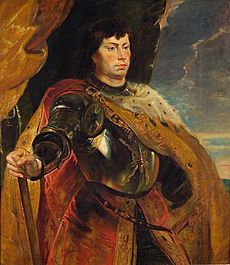
In 1474, Charles started getting into more conflicts that led to his downfall. First, he argued with Archduke Sigismund of Austria. Charles refused to give back the lands he had bought in Alsace. Then, he had problems with the Swiss, who supported towns rebelling against Charles's governor. Finally, he argued with René II, Duke of Lorraine over who should rule Lorraine, a land next to many of Charles's territories. All these enemies joined forces against Charles.
Charles faced a setback when he tried to help his relative, the Archbishop of Cologne. He spent ten months besieging the town of Neuss but had to give up when a large army arrived. Also, his ally, King Edward IV of England, made peace with Louis XI, which stopped their planned attack on France. Charles had more success in Lorraine, where he captured Nancy in 1475.
From Nancy, Charles marched against the Swiss. He made a harsh decision to execute the soldiers of Grandson after they surrendered. A few days later, on March 2, 1476, Charles was attacked by the Swiss army at the Battle of Grandson. He was defeated and had to flee, leaving behind his cannons and a huge amount of treasure.
Charles managed to gather a new army of 30,000 men. He used them to fight the Battle of Morat on June 22, 1476. But he was defeated again by the Swiss army, who were helped by the Duke of Lorraine's soldiers. This time, he lost about a third of his army. On October 6, Charles lost Nancy, which the Duke of Lorraine took back.
Death at Nancy
Charles made one last effort. He formed a new army and arrived at the walls of Nancy in the middle of winter. Many of his soldiers died from the cold. He met the combined forces of Lorraine and the Swiss, who came to help the town.
After the battle, Charles's body was found. A page reported that he had seen Charles die.
Charles's body was first buried in Nancy. Later, in 1550, his great-grandson, Holy Roman Emperor Charles V, ordered his body to be moved to the Church of Our Lady in Bruges, next to his daughter Mary. In 1562, a beautiful tomb was built over his burial place.
Marriages and Family
Charles married three times:
- His first wife was Catherine of France (1428–1446).
- His second wife was Isabella of Bourbon (1437–1465). They had his only child, Mary of Burgundy, born in 1457.
- His third wife was Margaret of York (1446–1503). She was the sister of two English kings, Edward IV of England and Richard III of England.
After Charles's death, his daughter Mary married Maximilian I, Holy Roman Emperor. Because of this marriage, many of Charles's lands became part of the Habsburg Empire.
His Nickname: "The Bold"
People who wrote about Charles in his time described him as strict, brave, and honorable. They called him le Hardi or der Kühne (both meaning "the Bold") or le Guerrier ("the Warrior"). The nickname that stuck, le Téméraire ("the Reckless"), was first used around 1484.
In the 15th century, these were just ways to describe his personality. He was simply known as Charles de Bourgogne (Charles of Burgundy). Over time, "the Bold" became his official nickname in history, especially in France and Belgium.
What Happened After Charles's Death?
Charles left his 19-year-old daughter, Mary of Burgundy, as his only heir. Her marriage was very important for the power balance in Europe. Both the King of France and the Holy Roman Emperor had unmarried sons. Charles had already thought about Mary marrying the Emperor's son, Maximilian.
King Louis of France tried to take over some of Charles's lands by force. This made it hard to arrange a marriage. Louis later said this was his biggest mistake. Meanwhile, the Habsburg Emperor acted faster. He arranged for his son Maximilian to marry Mary, with help from Mary's stepmother, Margaret. Maximilian admired Charles and continued many of his policies.
Because of Mary's marriage, much of the Burgundian lands became part of the Holy Roman Empire. For centuries, the border between France and the Holy Roman Empire (and later Germany) was often disputed, especially concerning areas like Alsace, Lorraine, and Flanders.
In Books and Movies
Charles the Bold appears as a character in several stories:
- He is a main character in Sir Walter Scott's 1823 novel Quentin Durward.
- He is also in Scott's later novel Anne of Geierstein.
- He is an important background character in The House of Niccolò book series by Dorothy Dunnett.
He has also been featured in films:
- Yolanda (1924)
- Le Miracle des loups (1924)
- Passport to Pimlico (1949) – This film has a fictional story where he survived.
- The Adventures of Quentin Durward (1955)
- Le Miracle des loups (1961)
Titles Held by Charles
 1433 – 1477: Count of Charolais as Charles I
1433 – 1477: Count of Charolais as Charles I 1467 – 1477: Duke of Burgundy as Charles I
1467 – 1477: Duke of Burgundy as Charles I 1467 – 1477: Duke of Lothier as Charles I
1467 – 1477: Duke of Lothier as Charles I 1467 – 1477: Duke of Brabant as Charles I
1467 – 1477: Duke of Brabant as Charles I 1467 – 1477: Duke of Limburg as Charles I
1467 – 1477: Duke of Limburg as Charles I 1467 – 1477: Duke of Luxemburg as Charles II
1467 – 1477: Duke of Luxemburg as Charles II 1467 – 1477: Count of Flanders as Charles II
1467 – 1477: Count of Flanders as Charles II 1467 – 1477: Count of Artois as Charles I
1467 – 1477: Count of Artois as Charles I 1467 – 1477: Count Palatine of Burgundy as Charles I
1467 – 1477: Count Palatine of Burgundy as Charles I 1467 – 1477: Count of Hainault as Charles I
1467 – 1477: Count of Hainault as Charles I 1467 – 1477: Count of Holland as Charles I
1467 – 1477: Count of Holland as Charles I 1467 – 1477: Count of Zeeland as Charles I
1467 – 1477: Count of Zeeland as Charles I 1467 – 1477: Count of Namur as Charles I
1467 – 1477: Count of Namur as Charles I 1467 – 1477: Margrave of Antwerp as Charles I
1467 – 1477: Margrave of Antwerp as Charles I 1473 – 1477: Duke of Guelders as Charles I
1473 – 1477: Duke of Guelders as Charles I 1473 – 1477: Count of Zutphen as Charles I
1473 – 1477: Count of Zutphen as Charles I
See also
 In Spanish: Carlos el Temerario para niños
In Spanish: Carlos el Temerario para niños
- Burgundian State
- Burgundian Netherlands
- Burgundian Wars
- Duchy of Burgundy
- Dukes of Burgundy family tree
- Jacques of Savoy, Count of Romont


